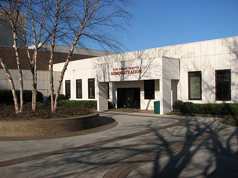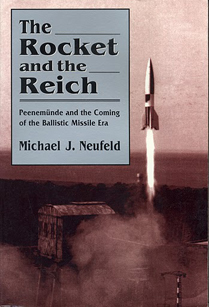Historians and Memorialists
During the early decades of the Cold War, vegetation, rock, forgetfulness, and myth buried the Dora camps and the Mittelwerk tunnels. Many people wanted the experience and place to disappear. By the late 1970s, however, shovels and research slowly excavated memory of Dora.
By 1947, people in Germany wanted to forget Dora. The Soviet Union occupied the Nordhausen region, stripped the tunnels of equipment, and dynamited the entrances. Like the US, the Soviet Union imported German rocketry technicians and strove to conceal their connection to the Nazi system. The local population also denied knowledge of and responsibility for Nazi crimes. Suffering from shortages, they dismantled the camp buildings for construction materials and firewood.
In the United States, the German engineers became respected American citizens and legendary technological heroes. They provided information to historians writing about the Peenemünde team; the historians became so closely identified with the Germans who came to Alabama that one scholar later dubbed them “the Huntsville school” of rocket history. Their books ignored slave workers, sanitized cruelty, or left the impression that V–2 assembly had been wholly an SS project. Hollywood films like the von Braun “biopic” I Aim at the Stars (1960) or the combat adventure Operation Crossbow (1965) left out slave labor. In the afterglow of the Apollo missions, Huntsville applied von Braun’s name to its civic center, and he and fellow engineers earned NASA honors.
Slowly, a new generation began to uncover Dora. In 1966 communist East Germany opened an official memorial and museum and in the 1970s restored the grounds of the Dora camp. Yet it reflected the East German state’s own legitimating myths, as it over–emphasized the anti–Nazi resistance of Communist prisoners and downplayed suffering of other groups. East German histories also sought to discredit the US by tying von Braun to Dora, but presented a caricature of him as a Nazi war criminal.
In the United States in the 1970s the ideological consensus of the Cold War loosened and a new scholarly understanding of the Holocaust developed. In 1979, a memoir by a Dora survivor drew attention to the forgotten camp, and the US Department of Justice began investigations that led to the Arthur Rudolph episode. Rudolph’s story, when it was released in 1984, made Mittelbau–Dora national news. Journalists and academics began in–depth research, some of it relying on the Freedom of Information Act to pry open secret files. New biographies and histories exposed the relationships of the V–2 project, the Nazi state, engineers, slave labor and the American military. The surviving Germans and the “Huntsville school” wrote responses, but their defenses were ineffectual in stemming the tide of revelations and unintentionally served to sustain academic interest in the subject.
The end of the Cold War and the reunification of Germany opened Dora to researchers, tourists, and students. In 1995, on the fiftieth anniversary of the liberation of the camp, the Dora memorial site had a new entrance that led to a re–opened section of the Mittelwerk tunnels. The Dora memorial museum and other European museums like La Coupole help keep Dora, the V–2, and slave labor in public memory.
Online Archives
- Research Department at the Buchenwald and Mittelbau–Dora Memorials Foundation Website, featuring Documentation, Library, and Research Projects (Click on “Mittelbau-Dora Concentration Camp Memorial,” and then Click on “Research”)
- Digital Collection at the Buchenwald and Mittelbau–Dora Memorials Foundation Website, featuring Documentation, Library, and Research Projects (Click on “Mittelbau-Dora Concentration Camp Memorial,” and then Click on “Digital Collection”)
Dora and Huntsville, Alabama
- 1950 Video Clip on von Braun Team’s Move to Redstone Arsenal in Huntsville
- “Operation Paperclip in Huntsville, Alabama,” chapter by Monique Laney, published in Remembering the Space Age (NASA, 2008).
- Power to Explore: A History of Marshall Space Flight Center 1960-1990 (NASA, 1999), by historians Dr. Andrew Dunar and Dr. Stephen Waring, especially Chapter I
- “Creating a Memory of the German Rocket Program for the Cold War,” chapter by historian Dr. Michael Neufeld, published in Remembering the Space Age (NASA, 2008).
- Marshall Space Flight Center Website on German Rocket Development, with No Mention of Mittelbau–Dora
- Defense of von Braun’s Involvement in Procuring Slave Laborers for Mittelbau–Dora by Fellow Engineer and Huntsvillian Dr. Ernst Stuhlinger, as part of National Public Radio Morning Edition Story on Dora from December 3, 1998
Dora Memorials in Germany and France
- Memorials at Mittelbau–Dora (Click on “Mittelbau–Dora Concentration Camp Memorial,” and then Click on “Outdoor Memorials” and then Click on “The Sub–camp Memorials” and “Commemorative Sites at Dora”)
- Remarks by the Honorable Warren L. Miller, Chairman, U.S. Commission for the Preservation of America’s Heritage Abroad, 60th Anniversary Ceremony of the Liberation of Mittelbau–Dora Concentration Camp April 11, 2005 Nordhausen, Germany
- Remembering the Nazi camps in East and West Germany: The case of the Mittelbau–Dora camp by Jens–Christian Wagner, Director of Mittelbau-Dora Memorial Site
- Virtual Reality Movies, film scenes of camp today, including its Memorial Wall
- “KZ Mittelbau Dora,” Tourist Video (in German)
- Photographs of Dora Today by Photographer Al Gilens
- Discussion of Visit to Mittelbau–Dora, by Photographer Al Gilens, as part of National Public Radio Morning Edition Story on Dora from December 3, 1998
- La Coupole, History and Remembrance Centre, Nord–Pas–de–Calais, Saint–Omer France
- Website of “Youth for Dora,” International Youth Organization Committed to Remembering the History of Dora and its Subcamps
- Brochure on International Workcamp 2009, organized by “Youth for Dora”




